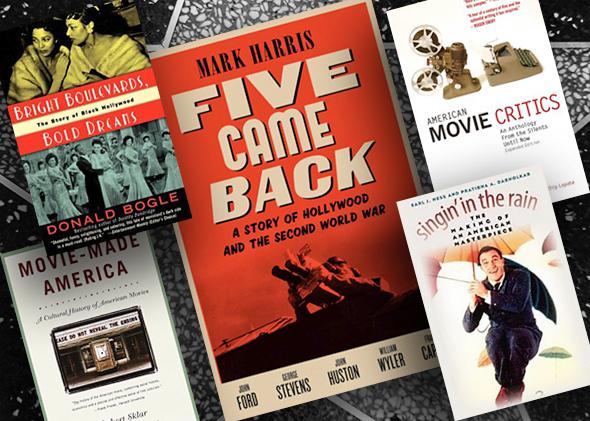I can pinpoint the exact moment when I first became enamored with “Old Hollywood,” that period in American cinema primarily defined as the reign of the studio system. I was 12 and spending the weekend at Grandma and Granddad’s, which included a trip to the late, once-great Blockbuster. One movie my grandma picked out was Some Like It Hot, and while about 80 percent of its gender-bending innuendo went over my head that night, something about Tony Curtis’ overwrought, sort-of British accent (which, I learned later, was really just faux Cary Grant), Jack Lemmon’s priceless reactions, and Marilyn Monroe’s breathy naiveté had me hooked.
Since then, I’ve harbored dreams of one day hosting Turner Classic Movies (Robert Osborne is my hero), I’ve received a graduate degree in film studies, and I try to write about old movies whenever I can, especially for Slate. Here are a few of my favorite books that explore Old Hollywood with great aplomb:
Five Came Back: A Story of Hollywood and the Second World War, by Mark Harris: I recently reviewed this for the Slate Book Review, and I couldn’t recommend it more highly. Not only is it a great profile of five legendary Hollywood directors, but it’ll also thoroughly satisfy WWII history buffs with a rare comprehensive look at the ways in which the government tried to sell the war to American audiences through film.
Bright Boulevards, Bold Dreams: The Story of Black Hollywood, by Donald Bogle: Spanning the ’10s through the ’50s, Bogle’s book examines the careers of Stepin Fetchit, Dorothy Dandridge, and many others, and the challenges they faced as actors of color. If you have even a passing interest in black Hollywood pre-1970, this is a great place to start; Bogle is a preeminent academic in the field of black film studies, but his writing style is engaging and accessible for the casual reader.
Singin’ in the Rain: The Making of an American Masterpiece, by Earl J. Hess and Pratibha A. Dabholkhar: A great, all-encompassing examination of one of my very favorite movies. Practically everything you’d ever want to know about one of the greatest movie musicals is in this book, including the songwriting, the screenplay, casting hurdles, and details of the production process. One fun bit of trivia I learned: Debbie Reynolds’ singing wasn’t the only thing she had dubbed in this great film that makes fun of dubbing—her tapping was replaced (with Gene Kelly’s) in the “Good Morning” number as well.
American Movie Critics: An Anthology From the Silents Until Now, ed. by Phillip Lopate: This massive collection of great film criticism is a fascinating entry point into exploring the cultural reception of older films. Many of the essays are about films pre-1960; there’s nothing quite like reading reviews of The Passion of Joan of Arc, King Kong, and Gone With the Wind from the years in which they were originally released. Variety critic Cecelia Ager’s review of King Kong is especially juicy, as she taunts Fay Wray, by then a frequent horror movie damsel in distress: “She screams quite as shrilly as if she couldn’t remember from her past encounters that she will surely be saved at the end.”
Movie-Made America: A Cultural History of American Movies, by Robert Sklar: First published in 1975 and updated and revised in the years following, this is the quintessential study of cinema’s emergence as a dominant cultural force in America. From the early beginnings of the moving image through the “decline” of movie culture in the ’50s and ’60s, it’s perfect for anyone interested in Old Hollywood and how it transformed the nation in its 20th-century boom.
